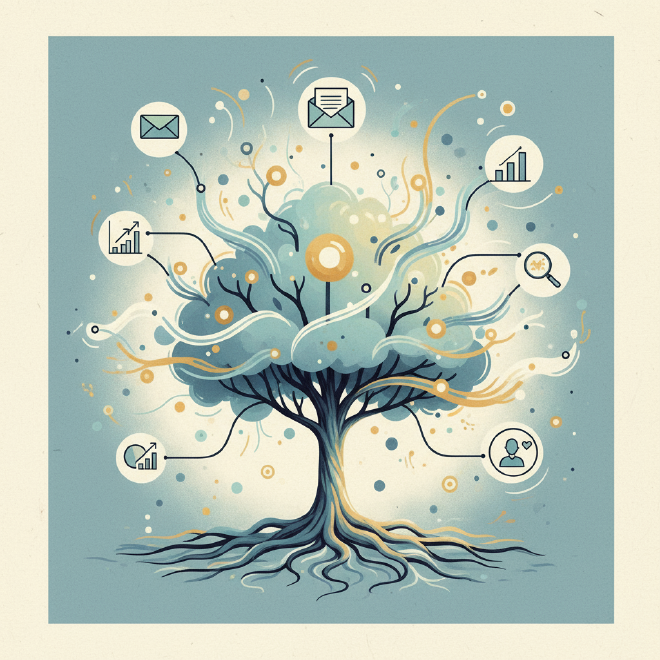Email Marketing Multi-Tool Trap: Consolidate & Boost ROI
Table of Contents
The Multi-Tool Trap: Why Your Email Marketing Stack is Costing You More Than You Think (And How to Fix It) #
Meta Description: Is your email marketing tech stack a tangled mess? Discover the hidden costs of fragmented tools, from integration nightmares to deliverability issues, and learn how consolidating your email marketing can boost efficiency, ROI, and brand consistency.
You know that feeling, right? That initial excitement when you discover a new tool that promises to solve that one specific problem in your email marketing. Maybe it’s a super slick abandoned cart recovery app, or a pop-up builder with AI-driven recommendations, or a review request system that integrates with your store. Each one, on its own, seems like a brilliant idea. A silver bullet, almost.
And so, you add it to your arsenal. Then another. And another. Before you know it, your email marketing “stack” isn’t a streamlined system; it’s a sprawling, tangled mess of subscriptions, logins, and slightly-off integrations.

Sound familiar?
This, my friend, is the multi-tool trap. It’s a common pitfall for small business owners and marketing professionals, especially in e-commerce, who are trying their best to optimize every touchpoint. We assume that specialization equals optimization. But honestly? It often equals complexity, inefficiency, and a whole lot of hidden costs that are quietly eating away at your bottom line and your sanity.
Let’s talk about why this happens, what it’s really costing you, and how you can escape this trap for good.
The Allure of Specialization (And Its Hidden Costs) #
It’s easy to get sucked in. Who doesn’t want a killer abandoned cart sequence? Or a pop-up that converts like crazy? Each specialized tool comes with compelling marketing, showcasing its unique brilliance. You think, “Great! This will make my email marketing even better.”
But here’s the thing: those subscription fees you see? They’re just the tip of the iceberg when it comes to the email marketing hidden costs.
Think about it this way:
- The Time Drain: Every new tool means another onboarding process, another interface to learn, another set of settings to configure. Multiply that by five or ten different tools, and suddenly you’re spending more time managing your tech than actually marketing. Your valuable time, or your team’s, is getting chipped away, piece by piece.
- Developer Dependency: Remember that “easy integration”? Sometimes it is, sometimes it’s not. When things break (and they will), or when you need a custom data flow, suddenly you’re begging for developer time. And developer time, as we all know, is expensive. These email marketing integration challenges aren’t just annoying; they’re a significant operational cost.
- Feature Overlap & Redundancy: You might have three different tools that could do segmentation, but each does it slightly differently. Or two pop-up builders. Or a welcome series in one, and a post-purchase series in another. You’re paying for features you already have, or worse, creating conflicting campaigns.
This fragmented email marketing tech stack isn’t just about money; it’s about mental load. It’s about the constant hum of “Is this working? Is that synced? Did I update the list in all the places?”
Integration Headaches: The Silent Killer of Productivity #
Let’s get real for a second. We’ve all been there. You set up an integration, it works for a bit, and then…poof. It breaks. Maybe an API changed, maybe a field mapping got messed up, or maybe someone updated a plugin somewhere else.
Suddenly, your carefully crafted customer journey is a mess. New subscribers aren’t getting their welcome emails. Abandoned carts aren’t being followed up on. Data isn’t flowing correctly between your e-commerce platform, your pop-up tool, and your main email sender.
This isn’t just an inconvenience; it’s a massive productivity drain. You’re losing potential sales, frustrating customers, and spending hours troubleshooting instead of strategizing. And beyond just data flow, there’s the aesthetic nightmare.
You might have a beautiful brand guide, but how do you enforce it across five different email builders? One tool uses one font, another another. Buttons look different. Footer disclaimers are inconsistent. Your brand voice gets diluted, chopped up, and reassembled like a Frankenstein’s monster of marketing. This lack of a cohesive brand experience isn’t just ugly; it erodes trust.

The Deliverability Dilemma: Why Your “Fancy” Emails Land in Spam #
Here’s a big one that often gets overlooked, but it’s crucial for your ecommerce email automation ROI: deliverability.
You might be using a high-end email service provider (ESP) for your main campaigns, but then you’ve got a third-party pop-up tool sending welcome emails, and another service handling review requests. Each of these tools might have its own way of constructing email code.
Many specialized tools, especially those focused on “fancy” designs or drag-and-drop simplicity, can generate what we call “high-HTML” templates. These templates, while visually appealing, can sometimes be bloated with unnecessary code, inline styling, and even hidden elements that spam filters hate.
Think about it: spam filters are looking for red flags. Inconsistent sender authentication (SPF, DKIM records), weird code, unusually large email sizes, or a sudden change in sending patterns can all trigger alarms. When you’re sending emails from multiple platforms, each with its own sending infrastructure and coding practices, you’re essentially playing Russian roulette with your domain reputation.
One tool’s poor coding or less-than-stellar sending practices can negatively impact your overall email deliverability best practices, dragging down the performance of all your emails, even those from your primary ESP. This means lower open rates, lower click-through rates, and ultimately, lost revenue. It’s like having a beautiful car but putting cheap, mismatched tires on it – you’re not going to get far, or safely.
Plus, managing invalid addresses and unsubscribe requests across multiple platforms is a nightmare. Get it wrong, and you’re looking at higher bounce rates and spam complaints, further damaging your sender reputation.
Escaping the Trap: Auditing Your Email Marketing Stack #
Okay, so we’ve established the problem. Now, what’s the solution? It starts with a good, hard look at what you’re currently using. It’s time to audit your email marketing tech stack.
Grab a coffee, open a spreadsheet, and let’s do this:
- Inventory Everything: List every single tool you use that touches your email marketing. Pop-ups, lead magnets, abandoned cart, review requests, segmentation, analytics, main sender, transactional emails, loyalty programs, calendar bookings – if it sends an email or collects an email address, write it down.
- Assess Functionality & Cost: For each tool, ask:
- What specific problem does it solve?
- What features do I actually use?
- What’s the monthly/annual cost?
- How much time (and therefore money) does it take to manage?
- How well does it integrate with my other tools? (Be honest, not optimistic!)
- Identify Redundancies & Underperformers:
- Are there two tools doing essentially the same thing?
- Is there a tool you’re paying for that you barely use, or that causes more headaches than it solves?
- Which tools are causing integration issues or brand inconsistency?
This audit isn’t about finding fault; it’s about finding clarity. You’ll likely discover you’re paying for features you don’t need, or that one tool’s “special” feature is actually available (and better integrated) elsewhere.
The Power of Consolidation: Streamlining for Success #
Once you have your audit results, the path forward becomes clearer: consolidate email marketing tools.
Imagine this:
- One Platform, One Login: All your email campaigns, automations, segmentation, analytics, and even pop-ups, living happily in one place. No more jumping between tabs or remembering a dozen passwords.
- Cohesive Branding: Design your templates once, and they’re consistent across every single email – from welcome sequences to abandoned cart reminders to newsletters. Your brand voice is unified, professional, and trustworthy.
- Seamless Data Flow: Your subscriber data, purchase history, and engagement metrics are all in one central contact management system. This means more powerful segmentation and truly personalized campaigns, without the integration headaches.
- Optimized Deliverability: With a single, robust platform handling your sending, you benefit from their expertise in domain reputation protection, invalid address filtering, and proper unsubscribe management. Your emails are more likely to land in the inbox, not the spam folder.
- Clearer Analytics, Better ROI: All your performance data (open rates, CTR, conversions) is in one dashboard. You can see the full picture, understand what’s working, and make data-driven decisions to boost your ecommerce email automation ROI.
This isn’t just about saving money on subscriptions (though you probably will!). It’s about reclaiming your time, reducing your stress, and making your email marketing genuinely more effective. It’s about shifting from managing a complex tech stack to focusing on what really matters: connecting with your audience and growing your business.

If you’re feeling bogged down by your current setup, it might be time to explore platforms that bring it all together. Think about an all-in-one solution that offers powerful automation, smart segmentation, intuitive design tools, and robust analytics, all while keeping deliverability top-of-mind. Many even offer flexible, pay-as-you-go pricing, so you only pay for what you use, making it super low-risk to get started. You can often find a free trial to test the waters, which is a great way to see the difference firsthand. A platform like that could be the key to unlocking your email marketing’s true potential. Learn more about streamlined email marketing solutions here.
Ready to Ditch the Multi-Tool Madness? #
The multi-tool trap is real, and it’s costing businesses more than just subscription fees. It’s costing time, focus, deliverability, and ultimately, sales. But you don’t have to stay caught in it.
Take that first step today: audit your current email marketing stack. Be honest about what’s working and what’s not. You might be surprised by how much you can simplify, streamline, and amplify your email marketing efforts just by consolidating your tools. Your inbox, your budget, and your customers will thank you.